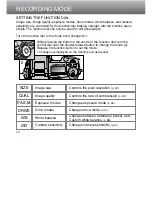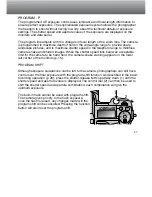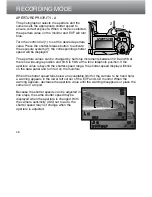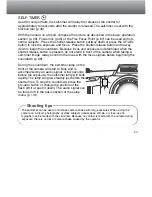
44
RECORDING MODE
Because super-fine and RAW data files are so large, the continuous-advance mode (p.52) cannot be
used with these image-quality settings. If the continuous advance is used with either of these
settings, only one image will be captured when the shutter-release button is pressed and held. With
the bracketing drive mode, the continuous advance is cancelled and the shutter must be released
manually for each frame of the bracket. When capturing super fine and RAW images, a delay of
between thirty to forty seconds can occur as the image is saved to the CompactFlash card; the
monitors will be blank and the access lamp will glow during that period.
In the RAW image-quality mode, the image size is set at full and cannot be changed. The image size
will not be displayed in the monitor. The digital zoom, enlarged playback, and data imprinting cannot
be used.
Unlike the other image-quality modes, RAW image data is unprocessed and requires image
processing before it can be used. To view the RAW data, the DiMAGE Image Viewer Utility software
is required. The utility software can reconstruct the image and apply the same image processing
controls as the camera. RAW data is saved as a 12-bit file; the DiMAGE Viewer Utility software can
convert this data into 48-bit TIFF files.
When the camera is set to RAW image quality, the camera’s image processing controls alter the live
image displayed in the EVF and on the LCD monitor in recording mode, but have no effect on the
stored image. When the image is played back on the camera, image processing is not applied and
the colours of the image can look unnatural. When viewed on a computer using the DiMAGE Image
Viewer software, the natural colours will be restored.
A RAW image is stored with a file header that contains white-balance information, changes made to
contrast and saturation with the digital effects controller, any image processing applied in a subject-
program setting, and changes to sharpness. The colour mode has no effect on the final image; a raw
image taken in the black and white mode can be restored to a colour picture. The changes in camera
sensitivity are applied to the RAW data; ISO values can be manually set to control noise (p. 62).
ABOUT SUPER-FINE AND RAW IMAGE QUALITY
If JPEG or TIFF files are retouched and overwritten with image processing applications that do
not support Exif files such as Adobe Photoshop, they can not be read or displayed in the DiMAGE
Image Viewer Utility (an error message "File not supported" appears).
Note
Summary of Contents for Dimage 5
Page 1: ...9224 2773 11 H A106 INSTRUCTION MANUAL E ...
Page 149: ......
















































